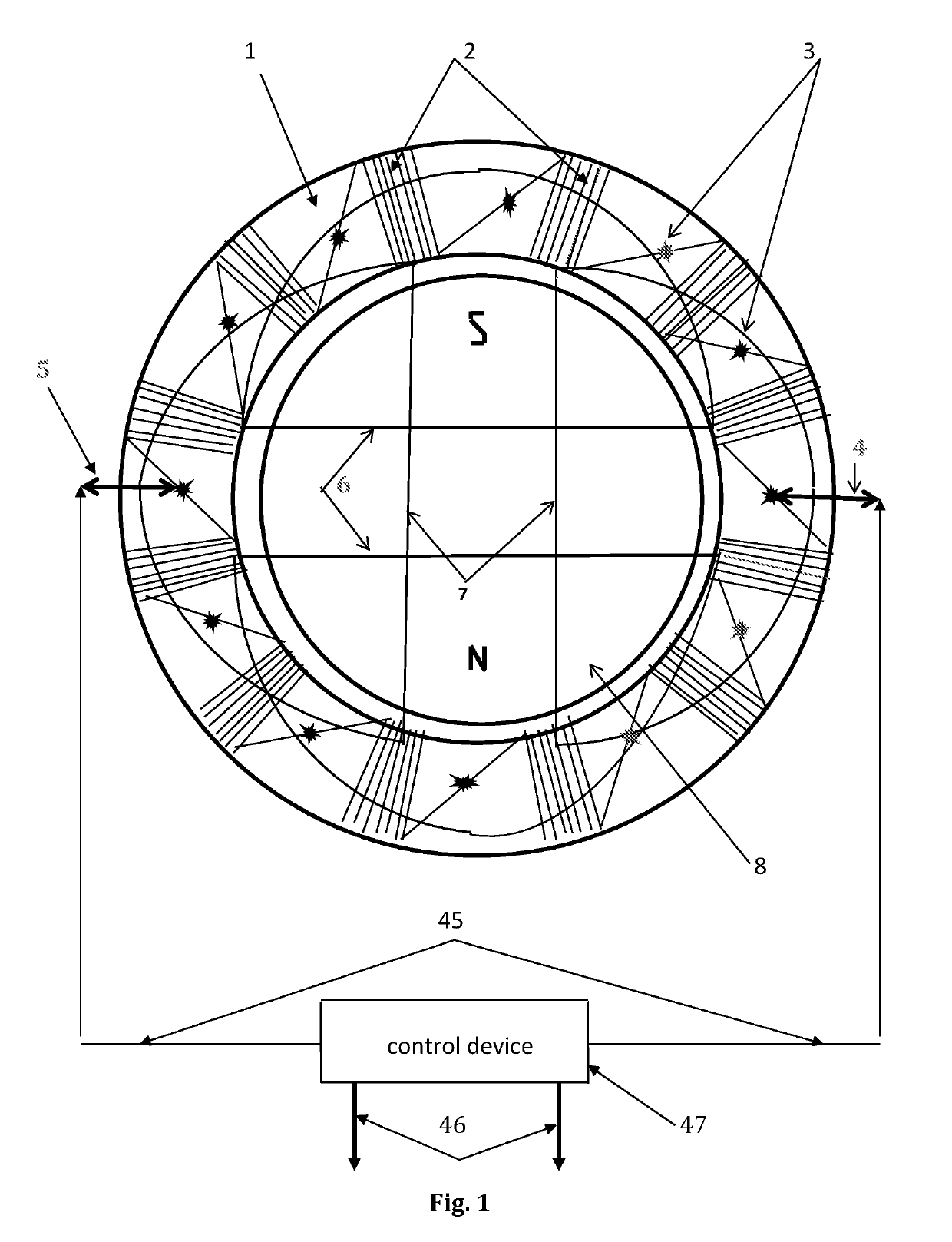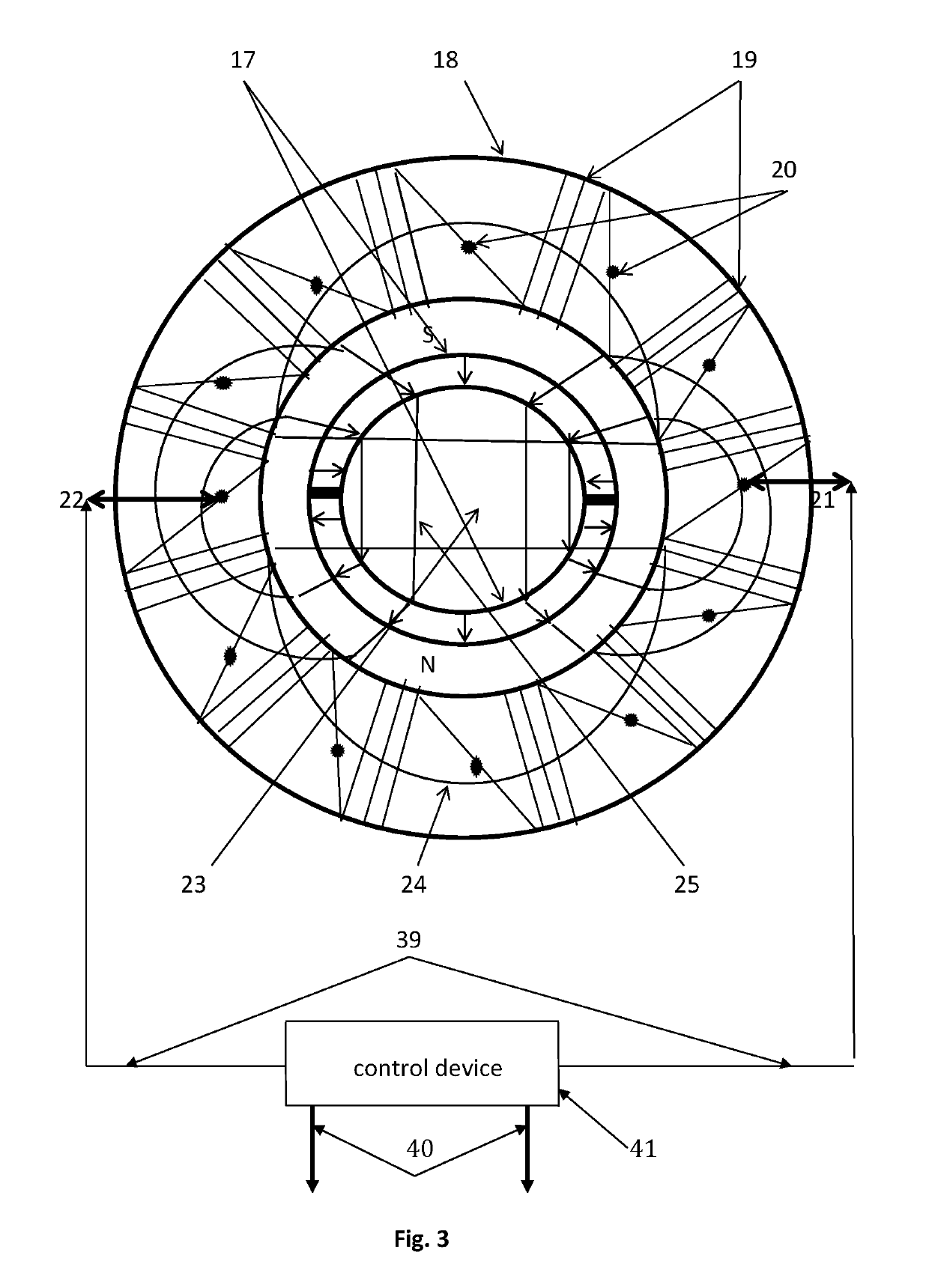Electric machine
a technology of electric machines and motors, applied in the direction of windings, mechanical energy handling, association with control/drive circuits, etc., can solve the problems of design function but not optimal, and achieve the effects of high efficiency, high performance and specific power
- Summary
- Abstract
- Description
- Claims
- Application Information
AI Technical Summary
Benefits of technology
Problems solved by technology
Method used
Image
Examples
example 1
[0029]FIG. 1 depicts an end view of the magnetic system of a DC electric motor, or DC power generator which consists of the magnetically soft core of the stator (1) with tangential, connected in series stator winding coils (2), their electrical terminals (3), and a control device (47) with terminals / wires (45), which, at each point in time connects an external two-wire grid (46), via electric contacts (4) and (5), with the specified, connected in series, tangential coils (2) of the stator winding. At subsequent times, the control device selects new terminal / wires that connect the external two-wire grid with new contacts of the stator coil. In this case, force lines (6) and (7) of the magnetic field of the stator (1) and the rotor (8) penetrate the core of a two-pole rotor (8) and have an almost stable relative orientation during the rotation of the rotor (8) (approximately mutually perpendicular), which ensures a torque stability of the rotor (8) under a steady load.
[0030]In this el...
example 2
[0032]FIG. 2 shows an end view of the magnetic system of a DC electric motor, or DC electric generator, which consists of the magnetically soft core of the stator (9) with radial, connected in series stator winding coils (10), their electrical terminals—contacts (11), and a control device (44) with terminals / wires (42), which at any point in time connects an external two-wire grid (46) via electric contacts (12) and (13), with the specified, radial stator coils (10) connected in series. At subsequent times, the control device selects new terminal / wires that connect the external two-wire grid with new contacts of the stator coil. In this case, power lines (14) and (15) of the magnetic field of the stator (9) and the rotor (16) penetrate the core of a double-pole rotor (16) and have an almost stable relative orientation during the rotation of the rotor (16) (approximately mutually perpendicular), which ensures a torque stability of the rotor (16) under a steady load.
[0033]In this elec...
example 3
[0035]FIG. 3 shows an end view of the magnetic system of a DC power generator which consists of a rotor (17) with two beveled poles and a magnetically soft core of the stator (18) with tangential, connected in series to stator winding coils (19) and their electric terminals (contacts) (20) connected with the corresponding electric contacts (21) and (22) with terminals / wires (39) of a control device (41), which, in turn, at any point in time directs the induction electric current produced in the stator coils to the terminals of an external two-wire grid (40). At subsequent times, the control device selects new terminal / wires that connect the external two-wire grid with new contacts of the stator coil. The internal part of the rotor (23) is made of a nonmagnetic material. Lines (24) and (25) are magnetic lines of the stator (18) and the rotor (17), respectively.
[0036]Definition 5. The two-pole rotor shown in FIG. 3, which consists of a hollow cylinder with two equal-sized magnets loca...
PUM
 Login to view more
Login to view more Abstract
Description
Claims
Application Information
 Login to view more
Login to view more - R&D Engineer
- R&D Manager
- IP Professional
- Industry Leading Data Capabilities
- Powerful AI technology
- Patent DNA Extraction
Browse by: Latest US Patents, China's latest patents, Technical Efficacy Thesaurus, Application Domain, Technology Topic.
© 2024 PatSnap. All rights reserved.Legal|Privacy policy|Modern Slavery Act Transparency Statement|Sitemap



